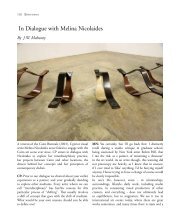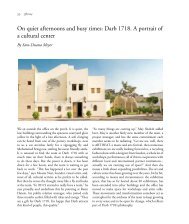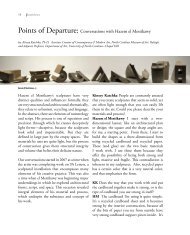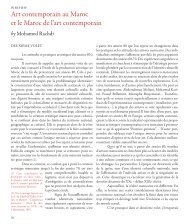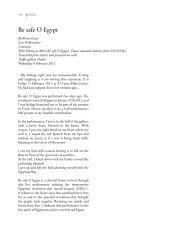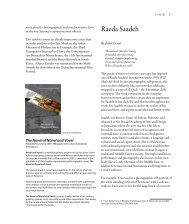Nikoo Tarkhani - Contemporary Practices
Nikoo Tarkhani - Contemporary Practices
Nikoo Tarkhani - Contemporary Practices
Create successful ePaper yourself
Turn your PDF publications into a flip-book with our unique Google optimized e-Paper software.
Profiles<br />
169<br />
Video Still from “the first part of the trilogy Song of Songs, 2012, a video-performance,14 minutes - Courtesy of Anahita Art studio.<br />
presents herself as the victim attacked by sparrows and<br />
nightingales, the native fauna of a world of ornaments<br />
reminiscing classic Persian gardens, love and poetry. In<br />
the fright of a long winter to come, birds are gathering<br />
food, plucking <strong>Nikoo</strong>’s body, unearthing her vessels and<br />
leaving her in a still agony. It seems that she believes<br />
her traditional roots have grown in a hostile ground. As<br />
the roots scatter around, filling the soil with the porous<br />
botanic presence of an individual, the attributes of the<br />
two merge together shaping an inseparable duet of nonharmonious<br />
desires. Neither the birds nor the agonized<br />
narrator are willingly participating in this traumatizing<br />
carnival. In this series the scar is presented in a rather<br />
unfamiliar body; here the scar is not a mark that remarks<br />
a past. She depicts the genesis of the scar. Her imagery<br />
narrates the tale of the disobedient and the punishment<br />
it recalls. Moreover, she reads her punishment as she<br />
remembers it, hence the unity of herself and the imposer.<br />
The two dimensional floral margins and ornaments<br />
that have long symbolized the ideal realm of Khayal3,<br />
contrasting with the materialized three dimensional<br />
body of the dug, reveal the subjective presence of<br />
the wound. Again in a different setting, she presents<br />
whatever she has suggested throughout her painting<br />
career in her videos. In the song of songs she reappears<br />
holding a concise interpretation, a golden key to her<br />
entire lexicon of objects and metaphors. In this code of<br />
codes she presents a more polished and mature version<br />
of her reading of the father, the formation of the ‘I’ and<br />
her statements on gender. What addresses a new chapter<br />
in her works is that as she moves forward she refuses<br />
auxiliary meanings. By the virtue of such refusal she



